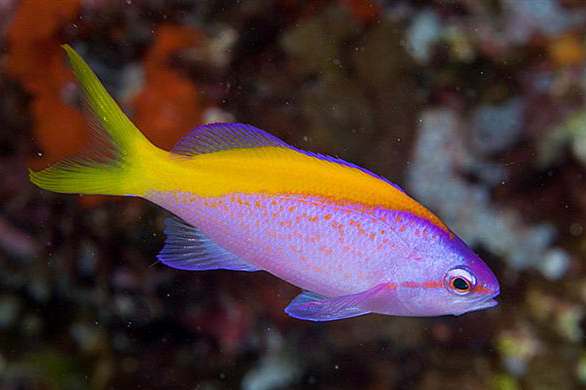Yellowback Anthias, Mirolabrichthys evansi (Smith 1954)
Other Names: Evansi Anthias, Goldback Anthias, Goldback Basslet, Yellow-back Queen-basslet

A Yellowback Anthias, Pseudanthias evansi, in the Maldives. Source: Jim Greenfield / FishBase. License: All rights reserved
Summary:
A violet basslet with males having an orange band through the eye, a broad yellow area on the back, dorsal fin and caudal fin, and scattered yellow spots on the side. Females are pinkish below with yellow dorsal and caudal fins, and a yellow area on the upperpart of the head and body. Males have a fleshy protuberance on the snout, elongated caudal-fin lobes, and filamentous tips on the pelvic fins.
This species was previously known as Pseudanthias pascalus.
Video of Yellowback Anthias in an aquarium.
This species was previously known as Pseudanthias pascalus.
Video of Yellowback Anthias in an aquarium.
Cite this page as:
Bray, D.J. 2023, Mirolabrichthys evansi in Fishes of Australia, accessed 03 Jul 2025, https://fishesofaustralia.net.au/Home/species/5115
Yellowback Anthias, Mirolabrichthys evansi (Smith 1954)
More Info
|
Distribution |
Recorded from the Australian territories of Christmas Island and Cocos (Keeling) Islands in the eastern Indian Ocean. Elsewhere the species is widespread, although relatively uncommon, in the Indian Ocean. Inhabits outer-reef lagoons and the upper parts of reef drop-offs. |
|
Feeding |
Large schools feed on zooplankton above the reef. |
|
Etymology |
The species is named in honour of Frank V. Evans, Esq., of Durban, South Africa, who “greatly assisted” J.L.B. Smith in his work. |
|
Species Citation |
Anthias evansi Smith 1954, Annals and Magazine of Natural History 12 7(73): 1, fig. 1. Type locality: Shimoni, Kenya. |
|
Author |
Bray, D.J. 2023 |
|
Resources |
Yellowback Anthias, Mirolabrichthys evansi (Smith 1954)
References
Allen, G.R., Steene, R.C. & Orchard, M. 2007. Fishes of Christmas Island. Christmas Island : Christmas Island Natural History Association 2 edn, 284 pp.
Allen, G.R. & Erdmann, M.V. 2012. Reef fishes of the East Indies. Perth : Tropical Reef Research 3 vols, 1260 pp.
Allen, G.R. & Smith-Vaniz, W.F. 1994. Fishes of Cocos (Keeling) Islands. Atoll Research Bulletin 412: 1-21
Allen, G.R. & Steene, R.C. 1988. Fishes of Christmas Island Indian Ocean. Christmas Island : Christmas Island Natural History Association 197 pp.
Gill, A.C. 2022. Revised definitions of the anthiadine fish genera Mirolabrichthys Herre and Nemanthias Smith, with description of a new genus (Teleostei: Serranidae). Zootaxa 5092(1): 041-066. https://doi.org/10.11646/zootaxa.5092.1.2
Hobbs, J-P.A., Newman, S.J., Mitsopoulos, G.E.A., Travers, M.J., Skepper, C.L., Gilligan, J.J., Allen, G.R., Choat, H.J. & Ayling, A.M. 2014. Checklist and new records of Christmas Island fishes: the influence of isolation, biogeography and habitat availability on species abundance and community composition. Raffles Bulletin of Zoology Supplement 30: 184–202
Hobbs, J-P.A., Newman, S .J., Mitsopoulos, G.E.A., Travers, M.J., Skepper, C.L., Gilligan, J.J., Allen, G.R., Choat, H.J. & Ayling, A.M. 2014. Fishes of the Cocos (Keeling) Islands: new records, community composition and biogeographic significance. Raffles Bulletin of Zoology Supplement 30: 203–219
Kuiter, R.H. 2004. Basslets, Hamlets and their relatives. A comprehensive guide to selected Serranidae and Plesiopidae. Chorleywood, UK : TMC Publishing 1, 216 pp.
Randall, J.E. & Lubbock, R. 1981. A revision of the serranid fishes of the subgenus Mirolabrichthys (Anthiinae : Anthias) with descriptions of five new species. Los Angeles County Museum of Natural History Contributions in Science 333: 1-27 figs 1-18 (as Anthias evansi)
Smith, J.L.B. 1954. Two interesting new anthiid fishes from East Africa. Annals and Magazine of Natural History 12 7(73): 1-6
Smith-Vaniz, W.F., Carpenter, K.E., Borsa, P., Jiddawi, N., Obota, C. & Yahya, S. 2018. Pseudanthias evansi. The IUCN Red List of Threatened Species 2018: e.T117016784A117017184. https://dx.doi.org/10.2305/IUCN.UK.2018-2.RLTS.T117016784A117017184.en. Accessed on 31 July 2023.








